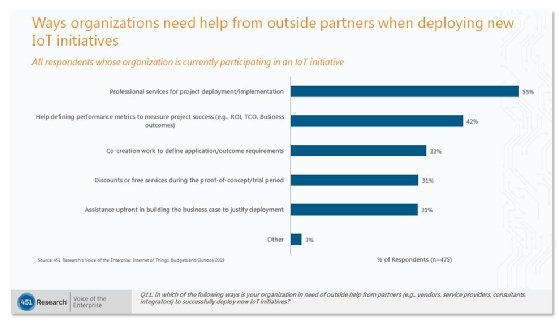
vege - Fotolia
IoT product development: Build vs. buy
The IoT product development process isn't as simple as adding connectivity and you're done. One key decision is determining if your company can roll its own or needs outside help.
While adding IoT capabilities to products may seem straightforward, it can be a daunting task with a few very different options -- should companies complete IoT product development in-house, with partners or via an online marketplace?
Companies with technical know-how in wire communications, data acquisition, data analytics and software development at the application level may have the competencies internally to embark on this journey alone, but most organizations don't have the internal skills to quickly start developing IoT products on their own.
One of the biggest challenges companies face is that it's technically difficult to create and demonstrate an IoT product -- including the hardware and software -- in highly reliable packaging that's ready to go out to end users in a problem-free, bug-free manner.
"Pretty much everything is connected now because people realized that if they connected their products, the data exhaust coming off of them can be monetized as a service," said Christian Renaud, analyst at 451 Research. "Companies are almost giving the box away now -- or in some cases are giving it away free -- to get you to subscribe to the data, which is a recurring revenue stream of data as a service for them."
While businesses can write their own code and integrate their own sensors, "companies are likely to make freshman mistakes when it comes to security, connectivity and data analytics -- as anyone who has tried to roll their own can tell you," Renaud said. "Or you can go with a commercial off-the-shelf IoT platform that has been hardened and deployed by a bunch of people, so you know it'll scale, it has features and capabilities that you need and they might be answering questions you didn't know you needed to ask."
 Christian Renaud
Christian Renaud
Companies new to the IoT realm also tend to make the mistake of assuming that if they're paying for something it's secure. "They don't always realize security is a feature," Renaud added. "Security shouldn't be a feature -- it should be baked in. But, they often don't know to ask about it. If it isn't secure, it's a really fast way to damage brand equity and corporate reputation."
Other key things to ask about before embarking on a connected product journey are scalability and references. And be sure you know why you want your product connected. "It's the people who don't come in with a 'why' that we see fail," Renaud said.

Handling the IoT product development process in-house
Enlighted Inc., an IoT company with a leading technology platform for smart commercial buildings and healthcare facilities, was one of the first to market with "enlighted" sensors. The company had to build everything end to end because no one at the time had IoT-enabled products that met its needs.
 Tanuj Mohan
Tanuj Mohan
One of the first questions to ask before embarking on an IoT do-it-yourself journey, according to Tanuj Mohan, founder, CTO and chief product officer at Enlighted, is: Does your business justify it? If not today, will it within three years? Carefully consider cost constraints, he cautioned, before heading down this path. If your goal is simply to just add connectivity and data to an existing product, "you don't want to do it in-house," Mohan said.
In-house IoT product development requires a diverse skill set of engineers and specialized knowledge of sensors. "A 40- to 50-person engineering team is the minimum you can start with," Mohan said. "Say you're a treadmill company and want to add IoT capabilities to it. You would definitely want to go to a third-party design house to build that for you. There's no point of bringing those skills in-house if it really isn't your core business. No one who builds products that already have a market and want to add IoT to them should ever try to build an in-house software team unless they believe their future is in data and they're planning to transform the company."
Another key question to ask: Are you adding a feature to a product for connectivity or access? Or are you changing the dynamics of the way something is being used or done today that tends to center around data?
"If you're bringing data to a situation that's never had data before, it can revolutionize that part of the market or even create one," said Mark Milligan, senior vice president of marketing at Enlighted.
 Mark Milligan
Mark Milligan
Enlighted, for example, puts sensors into lighting control systems within healthcare buildings to capture data about what's going on inside that previously wasn't available. "We're pushing the leading edge. From a cost perspective, building it out from end to end was the way to go for two reasons," Milligan explained. "First, we're doing something breakthrough with the technology and the components weren't even available when we got started. Second, even if they had been available, everyone wants a cut of that, which makes it uneconomical for us."
One of the main benefits of doing things in-house, Tanuj said, is that "if you build it outside the company, you're teaching other people your critical intellectual property and losing an advantage. Since we were on the leading edge and our IP was super valuable to us, it made more sense to keep it in-house."
Turning to product development partners
When should companies consider working with partners to add IoT capabilities to products?
"In the case of a company with the basic competencies internally, there may be bandwidth issues," explained Mitch Maiman, president and co-founder of Intelligent Product Solutions (IPS), which offers a full range of product development professional services. "If a company is bringing on the development and it's incremental to its core product base, it may not have enough bandwidth on hand to engage in those parallel activities or with that incremental level of work."
 Mitch Maiman
Mitch Maiman
More critically, Maiman pointed out, is if the company is coming to the table without those competencies. The question then becomes: How do we acquire them? "That's where I think a partnership with a firm like IPS makes a lot of sense, because that's where our competencies lie and we have all of the skills required to do IoT deployment," Maiman said.
It may be tempting for an IoT company to decide to hire a team to do that in-house, but Maiman cautioned that in this job market it may take you more than a year to assemble all of the critical skills you'll need. "It's an extremely tight job market right now, and the people with necessary skills are in short supply," he said. "A company that partners with a firm can quickly get embarked on a path of developing, executing and realizing IoT products."
IoT product development partners work within all market segments. For IPS, this includes working on products from smart vending machines and connected pianos to consumer products and medical devices to IoT sensors deployed within orchards and farms.
"The common denominator here is the skill set required to do these things: It cuts horizontally across all of these verticals, it's the same know-how," Maiman said. "There are certainly nuances to every client and their business, but once you learn that and go about attacking and solving the problems, it requires the same skill set and know-how that crosses over all kinds of domains."
Buying from an IoT development marketplace
Companies that want to add IoT connectivity to their product lines face numerous build versus buy decisions, explained Daniel Price, CEO and co-founder of Breadware, which provides an online marketplace of services to assist across the plan, build and launch stages of IoT product development.
Examples of questions companies should be asking, according to Price, include:
- Do you want to use an existing cloud platform to manage data or do you want to build one internally?
- Can you incorporate an off-the-shelf wireless radio or do you need to custom design one?
- Can an existing product be modified by the manufacturer to meet your needs or do you need to design your own product?
 Daniel Price
Daniel Price
The IoT space is a complex and rapidly evolving market that can be very difficult to know where to start -- especially for companies new to IoT. "The primary benefit of the Breadware marketplace is that it provides a single location for companies to find, qualify and engage with all the resources that they may need for their IoT initiative," Price said. "All services and technology solutions in the Breadware marketplace have gone through a vetting process by our quality assurance team."
Generally speaking, Price said, companies that lean more toward the "build" side of the equation can create IoT products that are more specialized for their customers, are a lower-cost unit and have higher performance. But, he pointed out, these products require much more engineering spend upfront and take longer to get to market.
"On the other hand, companies that lean more toward the 'buy' side of these decisions get IoT products to market much more quickly and with much less upfront out-of-pocket capital," Price added. "These products tend to have a higher unit cost, though, aren't as customized for the company's consumer base and don't have a refined user experience."
In either case, Price said that most IoT initiatives require collaboration with external partners. "To develop and launch the average IoT product, most companies are going to wind up working with between five to 10 external partner firms," he said. "For complex projects, the number can be even higher. I liken developing an IoT product to having all the pieces of a jigsaw puzzle -- and most companies don't. It often doesn't make sense for them to bring in these missing pieces internally as permanent departments because they may only need these services for a few months. That's why so many companies want to bring on strategic partners for their IoT initiatives."
Speed to market is critical
The IoT realm is akin to a "primordial soup" today, IPS' Maiman said, with things happening fast and all over the place. "Time to market is important because it provides leverage," he said. "Not everyone playing in the IoT space is going to survive long term. In fact, very few will survive as the market starts to mature. And it will mature -- we're starting to see some of that already. There will be players that drop out or get absorbed. The ones who get in early are going to have the ability to create continuing sustained value."
Just about any inanimate product or type of information that you could possibly want can be sensed or created at this point. And, unfortunately, you should assume someone else is already working on it if it isn't out there already -- so time to market is critical. "Protection of your IP and vigorous defense of it is also critical," Maiman pointed out.
Breadware's Price also noted that speed and cost to market as critical for many companies launching IoT initiatives. "Getting a product to market a few months before a competitor can allow capture of valuable early adopters," he said. "IoT products tend to be very sticky, so customers lost to competitors can take a long time to reclaim."






